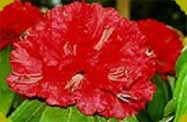|
Berberis aristata .Roxb.ex.Dc

|
Species |
Berberis aristata.
Roxb.ex.Dc |
|
Local Name |
Chut ro (Nep), Sung tung kung (Lep) |
|
Synonym |
|
|
Family |
Berberidaceae |
|
Habitat |
A large deciduous shrub usually 1.8-3.6 m high. Found in
waste grounds and in cultivated fields in the Himalayan
range. |
|
Distribution |
Distributed in the areas at an elevation of 6000 to
10,000 feet. |
|
Sikkim |
Hilley to Ribdi, Lachung to Zokophyak, Kupup, Nathang,
Tamjay, Lachen -Thongu, Bakhim- Dzongri, Tholong
monastery to Kisheong, Syano Ringdam to 5 mysterious
lake in North Siikkim. |
|
Out side |
Jammu and Kashmir, Himachal Pradesh (Simla,
Naggar, Sindh forest), Uttar Pradesh (Dunda, Ujha,
Daunagiri, Ranikhet, Harkidaon, Mukteshuara, Chamoli),
altitude- 2000 -3000 m. Also distributed in Nepal and
Bhutan |
|
General |
|
|
Morphological |
Deciduous, spinous shrub; 2- 4 m
tall. Bark pale-brown, closely and deeply furrowed;
branches shining, reddish brown. Leaves sessile, obovate
or elliptic, glossy dark green above, glossy pale green
beneath. Flowers yellow in corymbose raceme. Berries
oblong-ovoid, bright red. |
|
Flowering |
April -November |
|
Fruiting |
April-November |
|
History |
Berberis, a medicinal name, probably
of Arabic origin. The wood, rootbark and extract of
Indian barberry have been used in Hindu medicine since
time immemorial. |
|
Parts |
Fruits, stem and root-bark |
|
Status |
Vulnerable.
The species of berberis have been commercially exploited
for extraction of berberine. |
|
Phytochemistry |
The plants contain berberine, oxyberberine, berbamine,
aromoline, karachine, palmatine, oxyacanthine and
taxilamine. |
|
Agrocultivation |
|
|
Reference |
1.Anonymous (1985). The Wealth of
India (Vol.2). Publications and Information Directorate
CSIR. New Delhi. 116-117.
2.Bentley, Robert and Trimen Henry
(1989). Medicinal Plants (Vol.1). Bishen Singh Mahendraa
Pal Singh, Dehradun. 102-104.
3.Chatterjee, Ashima, Satyesh Chandra
Prakashi (1997).TheTreatise on Indian Medicinal Plants
(Vol. 1). Publications and Information Directorate. New
Delhi. 129.
4.Kumar, Sushil, Janardan Singh, N.C.
Shah, Vinay Ranjan (1997). Indian Medicinal and Aromatic
Plants Facing Genetic Erosion. Central Institute of
Medicinal and Aromatic Plants, Lucknow 55-59.
5.Kirtikar K.R., B.D. Basu (1993).
Indian Medicinal Plants (Vol.10). Bishen Singh Mahendra
Pal Singh, Dehradun. 102-104.
6 Progress Report of the Project "Studies on Medicinal
Plants of Sikkim"(1998-2001). State Council of Science
and Technology for Sikkim. |
|
Medicinal |
|
|
Ayurvedic |
The watery extract prepared from
roots, stem bark known as Rusot or Rasot, is used in
various forms of eye diseases and as a febrifuge. Rasaut
or Rasanjana prepared from root bark, root chips and
lower stem wood, obtained by boiling with water,
straining and evaporating till a dark brown sticky mass
is obtained is used as a bitter tonic, in fever, disease
of eye, liver and spleen, jaundice, piles. It is also
used for other infections.
a) Locally applied in affections of
eyelids and in chronic opthalmia.
b) In bleeding piles, administered in
doses of 5 to 53 grains with butter. Solution is used as
a wash for piles.
c) Ointment made with camphor and
butter is applied to pimples and oily skin.
The plant is also used in Unani
system of medicine in enlargements of spleen and as
emmenagogue and in cardiac dysfunction. |
|
Unani |
|
|
Traditional |
The matured fruit is smashed and given with food in case
of rabbies. |
|
Others |
The drug is antimalarial, antiseptic, blood purifier,
alterative antiphlogistic and sedative and is used in
conjunctivitis, enlargement of liver and spleen,
jaundice, periodic neuralgia, hemorrhoids, itching,
urinogenital disorders and ulcerative conditions. |
|
Prepartation |
1. Savarasa (juice) of the bark of
Daruharidra with equal amount of honey is to be taken
twice a day in treatment of jaundice.
2. What decoction prepared from the
bark, 14 ml- 28 ml is to be taken in jaundice. Decoction
of the root- bark is used as a wash for ulcers.
3.Tincture made from the root bark is
to be taken in cases of remittent as well as
intermittent fevers and also in debility.
4. In case of malaria and other intermittent fevers,
water extract is to be given twice daily. As an
antiperiodic, it has some advantages over quinine and
cinchona; its frequent and repeated doses do not produce
depression of the heart and deafness. |
|
Picture |
|
|
|
|
|

Rhododendron


Amongst the many
floral treaties of Sikkim Himalaya one of the earliest ones may be
found over the genus Rhododendron (Gk. rhodo = red, dendrons = tree
). |
| |
|
|
|

Orchid


Orchid
known for their brilliance in colors, unusual shapes
attractive growth habits, variety in fragrance and
exquisite beauty can attract any nature lovers.
|
| |
|
|
|

Medicinal Plant


Sikkim
with its total geographical area of 7,096 sq km is
bestowed with a huge diversity of flora and fauna.
|
| |
|
|
|
|
|